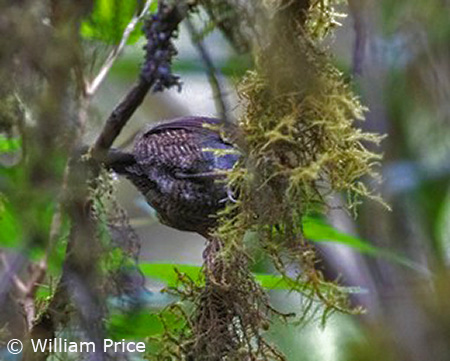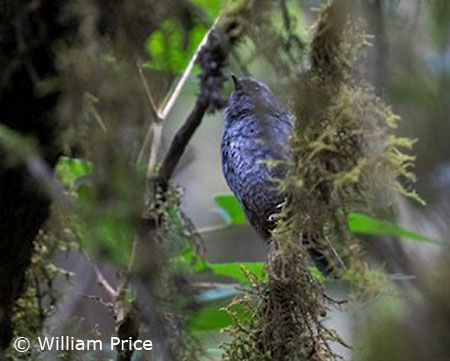
PROTECTION / THREATS / STATUS:
The IUCN has not assessed the recently described Ampay Tapaculo.
The species has restricted range at high elevation. It is widespread and common within the Santuario Nacional de Ampay which is partially forested and currently relatively secure.
It is fairly common locally in Apurímac where the habitat is patchy and threatened by grazing and burning.
In Ayacucho, the species is local and uncommon, restricted to ravines and steep slopes currently less affected by burning and grazing pressure.
It is suggested to qualify the Ampay Tapaculo as Near Threatened species.
Fr: Mérulaxe de Whitney
Ang: Ampay Tapaculo
All: Ampaytapaculo
Esp: Churrín de Ampay
Nd: Ampaytapaculo
Sd: ampaytapakul
Photographer:
William Price
PBase-tereksandpiper & Flickr William Price
Text by Nicole Bouglouan
Sources:
HANDBOOK OF THE BIRDS OF THE WORLD Vol 8 By Josep del Hoyo-Andrew Elliott-David Christie - Lynx Edicions - ISBN: 8487334504
BIRDS OF SOUTH AMERICA – Passerines - by Robert S. Ridgely and Guy Tudor – HELM Field Guides – ISBN: 9781408113424
BIRDS OF PERU by Thomas S. Schulenberg, Douglas F. Stotz, Daniel F. Lane, John P. O’Neill, Theodore A. Parker III – Princeton University Press 2007 – ISBN: 978-0-691-13023-1
Nest and nestling data for the unnamed ‘Ampay’ Tapaculo Scytalopus sp. from Apurímac, Peru
Fat birder - Rhinocryptidae – Tapaculos
CREAGUS@Monterey Bay (Don Roberson)
Three New Pieces to the Tapaculo Puzzle Provide A Window Into Andean Species Diversity
Wikipedia, la enciclopedia libre
Wikipedia, the free encyclopaedia
Ampay Tapaculo
Scytalopus whitneyi
Passeriformes Order – Rhinocryptidae Family
INTRODUCTION:
The Ampay Tapaculo is endemic to the eastern Andes in the Peruvian departments of Ayacucho and Apurimac, where it frequents montane forest and shrub, and also Polylepis incana forests. The species usually occurs at high elevation, up to 4,500 metres. It feeds on insects, worms and small arthropods taken on or near the ground.
The breeding behaviour is very poorly known, but from an observation, one nest was described. It was found in late December and was built within a deep, rocky crevice in a boulder field among shrubs and forbs. Two nestlings were in the nest, allowing the first description of these birds.
The name of the Ampay Tapaculo refers to Bosque Ampay where this species usually occurs. Both scientific and French names pay tribute to Bret M. Whitney who contributed to Neotropical ornithology, especially concerning the genus Scytalopus.
The Ampay Tapaculo has very restricted range in which it is described as common to local and uncommon.
The IUCN has not assessed this species, but it is suspected to be Near Threatened.

DESCRIPTION OF THE BIRD:
Biometrics:
Length: 10 cm
Weight: M: 15,5 g – F: 14 g
The Ampay Tapaculo was formerly within a clade including most of central and southern members of the Magellanic Tapaculo complex found from Peru to Argentina. It was described in April 2020.
Some minor morphological features make it slightly different and the plumage is darker grey overall.
These birds have short, rounded wings, stout legs and large feet, well adapted to their terrestrial behaviour.
The male is dark brown, mostly black on both lores and ocular area. On the upperwing, the tips of secondaries are brown to ochraceous tawny. The bars of lower back and rump, and edges and pre-subterminal tips to rectrices are strong brown to ochraceous-tawny.
The underparts are grey or dark grey with paler sheen on throat. The ochraceous-brown flanks, rump and vent are duller and darker, with fairly dense, narrow, straight, ochraceous-tawny barring. On the tail, the rectrices are dusky, with indistinct longitudinal dark yellowish-brown markings.
On the head, the crown is pale grey when seen head on, especially above the eye where we can see a faint, pale eyebrow. Lores and ocular areas are blackish.
The blackish bill is short, slender and pointed.
The eyes are dark brown.
Legs and feet are dark brown.
The female shows narrower but prominent pale supercilium. Nape and upper back are slightly browner than in male. Most of upperparts are dark reddish-brown. Wings, central and lower back, and uppertail-coverts are barred blackish.
On the underparts, throat and breast are paler grey. The lower underparts are buffy brown. Body sides, flanks and vent are barred black as in male, and the longitudinal marking on the tail is more pronounced in females.
Juveniles and immatures resemble male.
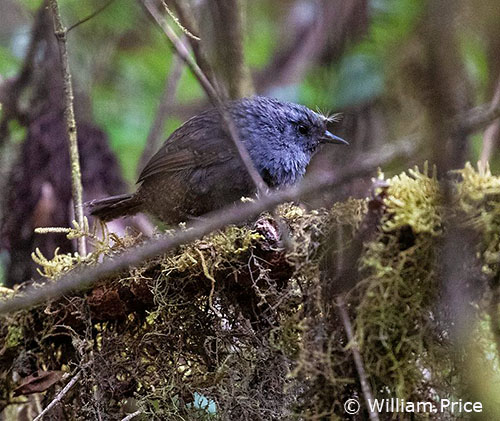
Probably an immature with some white down feathers on the forehead
RANGE:
The Ampay Tapaculo is found in two separate locations, in Apurímac and Ayacucho Departments.
The first area is in the Department of Apurímac, between the Apurímac and the Pampas Rivers.
The second location is in eastern Ayacucho, S of Mantaro River.
HABITAT:
The Ampay Tapaculo living in Ayacucho frequents shrubby (Baccharis) and bunchgrass (Festuca) areas on steep rocky slopes inaccessible to fire and cattle. It may occur from 3,500 to 4,200 metres of elevation.
In Apurímac, it is mainly found in montane forest and shrubland. It especially favours Podocarpus and Polylepis forests, between 3,150 and 4,500 metres of elevation.
CALLS AND SONGS: SOUNDS BY XENO-CANTO
The Ampay Tapaculos from Apurímac and Ayacucho have two song types, like several members of the Magellanic Tapaculo complex.
The primary song of the Apurímac species consists of a single, repeated note described as “chip”. It is given for up to 90 seconds or more.
The primary song of the Ayacucho species differs slightly from the previous, being on average higher pitched.
In Apurímac, the secondary song consists of regularly repeated churrs given at rate of 2/second, and lasting for up to 60 seconds.
In Ayacucho, there is only one example of secondary song having a slower pace of strokes.
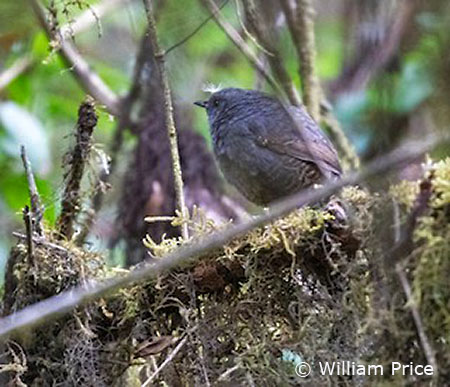
BEHAVIOUR IN THE WILD:
The Ampay Tapaculo probably feeds on small insects, worms and small arthropods.
It typically forages on the ground, but it also searches for prey by hopping along low branches, twigs and trunks near the ground.
The breeding behaviour is very poorly known. They are often seen in pairs, and both mates probably keep in vocal contact. The tapaculos are usually monogamous and very territorial.
From an observation, one nest was found in a rock crevice among boulders, shrubs and bunchgrass. The species is also known for nesting under tree roots and in burrows in banks.
Both parents apparently share the nesting duties.
The Ampay Tapaculo is resident and sedentary within its restricted range.
The short, rounded wings do not help the bird to fly. It is a fast-moving bird on the ground and it prefers to run under the vegetal cover when alarmed, but if necessary, it only performs very short flights.
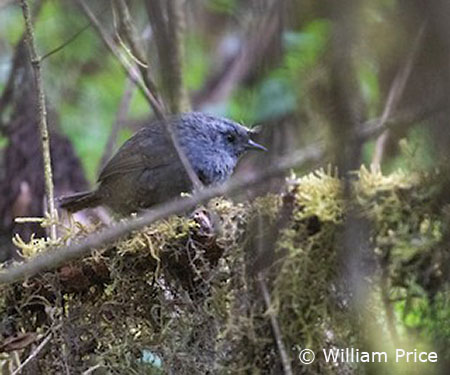
REPRODUCTION OF THIS SPECIES:
The breeding biology of the Ampay Tapaculo is poorly known. However, a nest was discovered on 21 December 2013 at 4,500 metres of elevation, 30 km SE of Abancay, Apurímac, Peru. This observation made it possible to describe the nest, the site and the nestlings, while both parents were feeding them, carrying food into a crevice between boulders.
The nest was deep inside the crevice (75 cm), placed within a boulder field among shrubs and grasses. Small rocks were at the entrance of the crevice, and patches of green moss were present on the two rocky walls forming the crevice.
The nest itself was a cup made of dry grasses and plant material. It was lined with softer material including brown moss and rootlets. The nest was 75 mm wide, whereas the inner cup was 55 mm wide. It was wedged on a rocky outcrop near the roof of the crevice.
Two nestlings were in the nest. Their skin was pinkish, but more yellowish-orange on the neck sides and pinker on the thighs. The legs were pale yellow with the tarsi tinged greyish.
The narrow bill was pale pink becoming darker grey at tip. It was bulging at the gape which was pale off-white to pallid pink.
Some mousy-grey down was present on the body, but it was predominant on the head with dense tufts on both crown and nape. Some sparse down persisted on wing-coverts, rectrices and vent. Some feathers had emerged on breast, back and rump. Patches of bare skin were still visible on neck sides, lower back, belly, underwing and rear flanks.
The nestlings were apparently 5-8 days old. The adults brought them invertebrates every 2-3 minutes. Both parents shared this activity, and probably all the nesting duties.
The species is also known for nesting under tree roots and in burrows in banks.
For more information: Nest and nestling data for the unnamed ‘Ampay’ Tapaculo Scytalopus sp. from Apurímac, Peru
